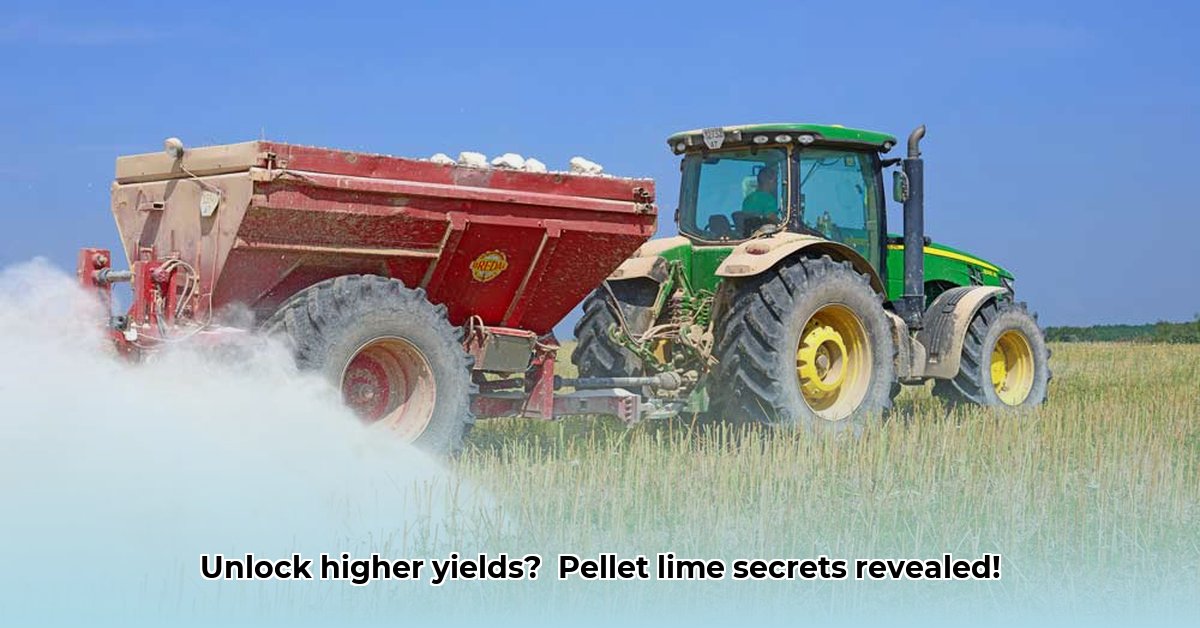
Healthy soil is the cornerstone of successful agriculture. Acidic soil, however, can significantly hinder crop growth by limiting nutrient availability. This guide provides a practical, step-by-step approach to using pellet lime, specifically Tractor Supply's brand, to improve soil health and boost crop yields sustainably. We'll cover everything from soil testing to application techniques, ensuring you get the best results from your investment. For more information on agricultural supplies, check out Tractor Supply's website.
Understanding Soil Acidity and Nutrient Deficiencies
Before applying any lime, understanding your soil's condition is paramount. Acidic soil, characterized by a low pH (below 6.5 for most crops), restricts the uptake of essential nutrients like phosphorus, potassium, and molybdenum. This leads to stunted growth, reduced yields, and increased susceptibility to diseases. Isn't it crucial to know the health of your soil before treating it? A simple soil test reveals your soil's pH and nutrient levels, providing a vital baseline for making informed decisions. You can purchase home testing kits or send samples to a soil testing laboratory—both are easy options.
Choosing and Applying Tractor Supply Pellet Lime
Tractor Supply offers various pelletized lime options. For most agricultural applications, dolomitic limestone is preferred as it provides both calcium and magnesium, vital nutrients for plant health. The pelletized form ensures even distribution, simplifying application. Always read the product label carefully—it provides essential information such as application rates and safety precautions. Ignoring this is like navigating without a map!
Calculating the Right Application Rate
Determining the correct amount of lime to apply is crucial for effectiveness. Over-application can lead to nutrient imbalances, while under-application won't significantly improve soil pH. Your soil test report will indicate the recommended lime application rate per acre (usually measured in tons). This isn't a guess. This is data driven! Sticking to the recommended amount is crucial for cost effectiveness and preventing damage.
Step-by-Step Application Guide
- Site Preparation: Clear the field of debris, rocks, and weeds to ensure even lime distribution. This preliminary step is critical for uniform treatment.
- Lime Spreading: Use a calibrated spreader for even distribution. Broadcast spreading is suitable for larger fields and banding (applying in rows) is suitable for smaller areas or row crops. A properly calibrated spreader is key. Why risk uneven application and its associated problems?
- Incorporation: Till or incorporate the lime into the topsoil. This enhances contact with the soil particles, accelerating the liming process. This step is particularly important in drier climates.
- Monitoring and Adjustment: After a specified time (check the product label for specifics), perform another soil test. This reveals the lime’s effectiveness allowing adjustments for future applications. Regular monitoring ensures long-term soil health.
Integrating Pellet Lime into a Sustainable Farming System
Using pellet lime is a sustainable practice. It's a natural soil amendment that gradually improves soil structure and nutrient availability without the harsh chemical runoff associated with some fertilizers. "Using pellet lime aligns perfectly with our commitment to sustainable agriculture," says Dr. Emily Carter, Soil Scientist at the University of California, Davis. "It's a natural way to enhance soil health without harming the environment." Integrating lime application with other sustainable practices, such as crop rotation and cover cropping, further enhances soil health.
Potential Challenges and Troubleshooting
While pellet lime offers numerous benefits, it's important to be aware of potential challenges:
- Over-application: Can lead to nutrient imbalances. Soil testing helps avoid this problem.
- Uneven Application: A properly calibrated spreader is essential to avoid poor results.
- Slow Reaction: Lime's effects aren't immediate; regular monitoring is key.
Comparing Dolomitic and Calcitic Lime
Choosing the right lime type is vital. Dolomitic lime contains both calcium and magnesium, benefiting magnesium-deficient soils—common in sandy areas. Calcitic lime, primarily calcium carbonate, is a more cost-effective option for soils already rich in magnesium. Your soil test results will guide your selection.
Weighing the Costs and Benefits
| Pros | Cons |
|---|---|
| Improves soil pH and nutrient availability | Requires initial soil testing |
| Provides essential calcium and magnesium | Can be labor-intensive, especially on large fields |
| Cost-effective long-term solution | Effects aren't immediate; patience is required |
| Environmentally friendly | Effectiveness varies depending on soil type and conditions |
| Enhances long-term soil health and fertility | May necessitate reapplication over several years |
Ultimately, using pellet lime correctly is an investment in the long-term health and productivity of your land. Remember, healthy soil leads to healthier plants and better harvests.